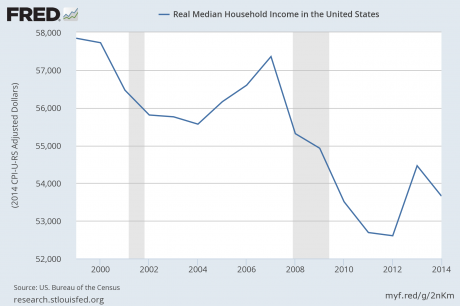 Has there ever been a major holiday more focused on materialism than the modern American Christmas? This year, Americans are planning to spend an average of 830 dollars on Christmas gifts, which represents a jump of 110 dollars over the average of 720 dollars last year. But have our incomes gone up accordingly? Of course not. In fact, real median household income in the United States has been experiencing a steady long-term decline. So in order to fund all of our Christmas spending, we have got to go into even more debt. We love to pull out our credit cards and spend money that we do not have on lots of cheap, useless stuff made on the other side of the world by workers making slave labor wages. We do the same thing year after year, and most of us have grown accustomed to the endless cycle of growing debt. In fact, one Pew survey found that approximately 70 percent of all Americans believe that “debt is a necessity in their lives”. But then we have to work our fingers to the bone to try to make the payments on all of that debt, not realizing that debt systematically impoverishes us. It may be hard to believe, but if you have a single dollar in your pocket and no debt, you have a greater net worth than 25 percent of all Americans. I know that sounds crazy, but it is true.
Has there ever been a major holiday more focused on materialism than the modern American Christmas? This year, Americans are planning to spend an average of 830 dollars on Christmas gifts, which represents a jump of 110 dollars over the average of 720 dollars last year. But have our incomes gone up accordingly? Of course not. In fact, real median household income in the United States has been experiencing a steady long-term decline. So in order to fund all of our Christmas spending, we have got to go into even more debt. We love to pull out our credit cards and spend money that we do not have on lots of cheap, useless stuff made on the other side of the world by workers making slave labor wages. We do the same thing year after year, and most of us have grown accustomed to the endless cycle of growing debt. In fact, one Pew survey found that approximately 70 percent of all Americans believe that “debt is a necessity in their lives”. But then we have to work our fingers to the bone to try to make the payments on all of that debt, not realizing that debt systematically impoverishes us. It may be hard to believe, but if you have a single dollar in your pocket and no debt, you have a greater net worth than 25 percent of all Americans. I know that sounds crazy, but it is true.
Overall, when you add up all forms of debt (consumer, business, local government, state government and federal government), Americans are more than 60 trillion dollars in debt.
Let that sink in for a bit.
40 years ago, that number was sitting at about 3 trillion dollars.
We have been on the greatest debt binge in the history of the world. Even though we were “the wealthiest, most prosperous nation on the entire planet”, we always had to have more. We just kept on borrowing and borrowing and borrowing from the future until we completely destroyed it.
And we still haven’t learned anything. Instead, this Christmas season we will be partying like it’s 2007…
Americans are planning on celebrating Christmas like it’s 2007.
A November survey by Gallup found that US adults are planning on spending about $830 on average on Christmas gifts this year.
That’s a huge jump from last year’s $720 average.
Notably, American consumers haven’t suggested a number that high since November 2007, when they were planning on spending $866 on average.
Sadly, our incomes simply do not justify this kind of extravagance. As Zero Hedge has pointed out, household incomes “actually peaked at least 15 years ago in 81% of U.S. counties.”
So why can’t we adjust our lifestyles to match?
Why must we always have more?
Here are more details on our declining incomes from the Visual Capitalist…
- Income peaked one year ago for many of the counties that are a part of the shale boom. This includes much of North and South Dakota, as well as parts of Texas, Nebraska, and Oklahoma. Income in Washington, D.C. and neighboring Arlington County also peaked then.
- In 1999, a total of 1,623 counties had their households reach peak income. The majority of these counties are in the Midwest and Southeast.
- The most southern part of California and parts of New England both peaked around 25 years ago.
- Many states along the Rocky Mountains such as Wyoming and Montana had counties that peaked roughly 35 years ago.
- Household income peaked in upstate New York, the northern tip of California, and southern Nevada at the same time that humans were first landing on the moon in 1969.
But you won’t hear this reported on the mainstream news, will you?
They want us to think that happy days are here again.
The following chart comes from the Federal Reserve, and it shows that real median household income in the United States has been trending down since 1999…
Americans should be having smaller Christmases instead of bigger ones, but that doesn’t fit the image of who we still think that we are.
Recently, I published an article entitled “Goodbye Middle Class: 51 Percent Of All American Workers Make Less Than 30,000 Dollars A Year” that was shared more than 44,000 times on Facebook. In that article, I included brand new figures that were just released by the Social Security Administration. As you can see, the quality of our jobs is not great…
-38 percent of all American workers made less than $20,000 last year.
-51 percent of all American workers made less than $30,000 last year.
-62 percent of all American workers made less than $40,000 last year.
-71 percent of all American workers made less than $50,000 last year.
Without a doubt, most American families should not be spending hundreds of dollars a year on Christmas gifts.
At these income levels, most American families are just barely surviving.
But once again this year, millions upon millions of Americans will flock to the malls and big box stores in a desperate attempt to make themselves happy.
Sadly, those efforts will be in vain. In fact, in a previous article I highlighted the fact that Christmas is the unhappiest season of the year. The suicide rate spikes to the highest level of the year during “the holidays”, and 45 percent of all Americans report that they dread the Christmas season. The following is an excerpt from a Psychology Today article…
We are told that Christmas, for Christians, should be the happiest time of year, an opportunity to be joyful and grateful with family, friends and colleagues. Yet, according to the National Institute of Health, Christmas is the time of year that people experience the highest incidence of depression. Hospitals and police forces report the highest incidences of suicide and attempted suicide. Psychiatrists, psychologists and other mental health professionals report a significant increase in patients complaining about depression. One North American survey reported that 45% of respondents dreaded the festive season.
In recent years, an increasing number of Americans have given up the tradition of Christmas gifts entirely, and many of them that I know seem quite happy to have done so.
Of course most people are still quite satisfied with the status quo, and there are many that will get very angry with you if you dare to suggest that the way that Americans celebrate Christmas has gotten way out of hand.
But shouldn’t it alarm us that for most Americans the biggest holiday of the year is all about the “stuff” they are going to buy, the “stuff” they are going to give and the “stuff” they are going to get?
As a society, we are obsessed with things, but those things are never going to make us happy.
Perhaps we should all take some time to reflect on the traditions that we choose to participate in and what they really mean to us during this “holiday season”…



